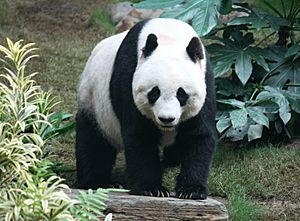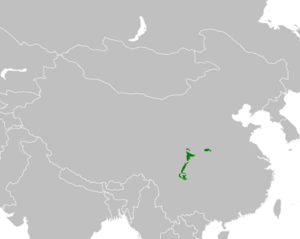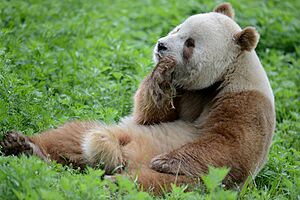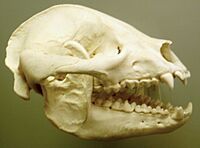Giant panda facts for kids
Quick facts for kids Giant panda |
|
|---|---|
 |
|
| A giant panda at Ocean Park Hong Kong | |
| Conservation status | |
| Scientific classification | |
| Genus: |
Ailuropoda
|
| Species: |
melanoleuca
|
| Subspecies | |
|
|
 |
|
| Giant panda range | |
The giant panda (Ailuropoda melanoleuca), also called the panda bear, is a type of bear. It lives only in China. These famous bears have black and white fur. They have black patches around their eyes, on their ears, legs, and shoulders. Pandas have a round body. They can weigh between 100 to 115 kilograms (220 to 254 pounds). They are usually 1.2 to 1.9 meters (4 to 6 feet) long.
Male pandas are a bit bigger than females. They have a special thumb-like bone on their front paws. This helps them hold bamboo stalks while they eat. Their strong jaws and large teeth are perfect for crushing tough bamboo. Even though they mostly eat plants (they are herbivorous), their bodies digest food like a meat-eater (a carnivore).
Giant pandas live in mountain areas in China. They can be found at heights up to 3,000 meters (9,800 feet). Pandas are solitary animals, meaning they live alone. They only meet up during the mating season. To talk to each other, they use smells. They leave scent marks on trees and rocks. A mother panda takes care of her cub for about 18 to 24 months.
Pandas have lost much of their home because of farming and building. But, people have worked hard to protect them. This has helped their numbers grow. In 2015, there were about 1,864 adult pandas in the wild. Because of this, their status changed in 2016. They went from "Endangered" to "Vulnerable." The panda is a loved national symbol of China. It has been on coins and was a mascot for the 2008 Summer Olympics in Beijing.
Contents
What's in a Panda's Name?
The word panda comes from the Nepali word ponya. This name was first used for the red panda. The red panda was discovered about 40 years before the giant panda. When the giant panda was found, people needed a way to tell them apart.
In Chinese, the most common name for the panda is dàxióngmāo. This means "giant bear cat." The scientific name, Ailuropoda melanoleuca, means "black and white cat-foot."
Types of Giant Pandas

Scientists have found two types of giant pandas. They look a bit different and have different genes.
- A. m. melanoleuca is the most common type of panda. It has the usual black-and-white fur. It lives mostly in the Sichuan province.
- The Qinling panda (A. m. qinlingensis) lives only in the Qinling Mountains. Its fur is dark brown and white, not black and white. It is also a bit smaller than the other type. It has bigger teeth too.
Studies show that the Qinling panda group became separate from other pandas about 300,000 years ago.
Where Do Giant Pandas Live?
Giant pandas are only found in China. They live in small, separate groups. These groups are in six different mountain ranges. Most of them are in the Sichuan province. Pandas like high-up forests. They live between 2,400 and 3,000 meters (7,900 to 9,800 feet) high. These forests must have lots of bamboo.
Pandas used to live in a much bigger area. This included parts of Myanmar and Vietnam. Over thousands of years, their home got smaller. This happened because of climate change and human actions. Today, their living area is tiny compared to what it once was.
What Do Giant Pandas Look Like?
The giant panda has a bear's body shape. But it has very special colors. Its black and white fur helps it hide. The white parts help it blend in with snow. The black patches on its legs and shoulders help it hide in the shade. The black patches around their eyes might help them know each other. Their black ears may show when they are angry. A thick, woolly coat keeps them warm in their cool mountain home.
A panda's skull and jaw are very strong. They are made to crush tough bamboo. Bamboo is the main food they eat. An adult panda can be 1.2 to 1.9 meters (4 to 6 feet) long. It can weigh up to 160 kilograms (350 pounds). But the average weight is about 115 kg (254 pounds).
One cool thing about a panda is its paw. It has five fingers and a special "pseudo-thumb." This "thumb" is actually a changed wrist bone. This extra part helps the panda hold bamboo stalks steady while it eats.
Ecology and Behavior
A Bamboo-Based Diet
Pandas are called carnivores, but they eat almost only bamboo. About 99% of their diet is bamboo. Their bodies are not very good at breaking down plants. So, they have to eat a huge amount. An adult panda might eat 9 to 14 kilograms (20 to 30 pounds) of bamboo every day. This is why they can poop up to 40 times a day!
This low-energy food makes them move slowly. Pandas usually avoid steep hills to save energy. Their large size and round face also help them with their diet. The round face is because of strong jaw muscles. These muscles help them chew tough bamboo.
Even though they mostly eat bamboo, pandas sometimes eat other foods. They might eat meat, fish, or eggs if they find them. In zoos, they get bamboo and special nutrient-rich biscuits.
Predators and Competitors
Adult giant pandas are big. They have few natural enemies. But young cubs can be hunted. Animals like snow leopards, yellow-throated martens, and Asian black bears might hunt them.
Pandas share their home with other animals that also eat bamboo. One example is the takin. To avoid fighting for food, pandas often stay away from areas where many other large animals live.
How Pandas Communicate
Giant pandas usually live alone. They spend most of their time by themselves. They roam and eat in bamboo forests. They do not have permanent homes. They also do not hibernate in winter. Instead, they move to lower places where it is warmer.
Pandas talk mainly using sounds and smells. They make a bleating sound to be friendly with each other. They also leave scent marks. They do this by rubbing their bodies on trees or spraying urine. These smells tell other pandas about their age and gender. They also show if they are ready to mate. This is very important because their mating season is very short.
Life Cycle and Reproduction
Giant pandas are ready to have babies when they are four to eight years old. The mating season is from March to May. A female can only get pregnant for two or three days each year.
After being pregnant for 95 to 160 days, a mother gives birth. About half the time, she has twins. In the wild, the mother can usually only take care of one cub. So, she will pick the stronger one. The father does not help raise the cubs.
A newborn cub is tiny, pink, and blind. It weighs only about 90 to 130 grams (3 to 5 ounces). That's about the size of a stick of butter! The cub's black and white fur appears after about a month. Cubs start to crawl at around 75 days. They can eat a little bamboo at six months old. They stay with their mothers for 18 months to two years. Then they start living on their own.
Pandas and People
Panda Diplomacy
Pandas have been kept in zoos for hundreds of years. In the 1970s, China started giving giant pandas as gifts. They gave them to countries like the United States and Japan. This showed friendship and was called "panda diplomacy."
By 1984, China changed its plan. Instead of giving pandas away, they started lending them. Other countries could borrow pandas for a fee. These loans usually last for 10 years. Any cubs born belong to China. Today, almost all giant pandas in zoos are on loan from China.
Keeping pandas in zoos costs a lot of money. It costs about five times more to care for a panda than for an elephant. An elephant is the next most expensive animal.
Conservation Efforts
The giant panda is a vulnerable species. This means it is at risk. Its biggest problems are losing its home and having very few babies. People are building more and more where pandas live. To protect them, the Chinese government has made many nature reserves.
In 1963, the Wolong National Nature Reserve was made. It was created to save the panda population. Since then, many more reserves have been made. In 2020, China put almost 70 reserves together. They formed the huge Giant Panda National Park. This park is about three times the size of Yellowstone National Park in the U.S.
These efforts have worked well. The number of pandas in the wild has been slowly growing. In 2016, the giant panda's status officially changed. It went from "Endangered" to "Vulnerable." Chinese officials say they will keep working hard to protect this loved animal. Protecting panda homes also helps other rare animals that live there. These include the snow leopard and the red panda.
Interesting Facts About the Giant Panda
- The giant panda has been on Chinese Gold Panda coins since 1982. It was also one of the five Fuwa mascots for the 2008 Summer Olympics.
- In China and Taiwan, the giant panda is sometimes called "spotted bear," "bamboo bear," or "giant bear cat."
- The giant panda shares traits with both bears and raccoons. But DNA tests show it is a true bear.
- The giant panda is more like an ancestor to other living bear species. It is sometimes called a living fossil.
- The giant panda's genome (its full set of DNA) was mapped in 2009.
- A 110.45 kg (243.5 lb) giant panda has a bite force of 2603.47 newtons. This is very strong!
- The giant panda's paw has a "thumb" and five fingers. The "thumb" helps it hold bamboo while eating.
- The giant panda's tail is 10 to 15 cm (3.9 to 5.9 in) long. It is the second-longest tail in the bear family. Only the sloth bear has a longer one.
- A female panda named Jia Jia was the oldest giant panda ever in a zoo. She was born in 1978 and died at 38 years old in 2016.
- The black patches around the giant pandas' eyes help them recognize each other.
- Pandas are born with clean intestines. They need bacteria from their mother's poop to digest plants.
- The average giant panda eats 9 to 14 kg (20 to 30 lb) of bamboo shoots a day. It poops up to 40 times a day.
- The giant panda is an animal with special ways of living. It has lived in bamboo forests for millions of years.
- It is thought that an adult panda takes in 54.8 to 66.1 mg of cyanide a day from its food. To avoid being poisoned, they have special ways to protect themselves.
- Pandas mainly use spatial memory (remembering places) instead of visual memory (remembering what things look like).
- The giant panda can attack humans. This is probably from being annoyed, not from being aggressive.
- Scientists are studying microbes in panda waste. They hope to use them to make biofuels from bamboo and other plants.
- Almost all pandas in the world belong to China.
- Chi Chi at the London Zoo became very popular. This led the World Wildlife Fund to use a panda as its symbol.
- Keeping a panda costs five times more than keeping an elephant. An elephant is the next most expensive animal.
Images for kids
-
The Qinling panda has a light brown and white pattern
-
Panda Research and Breeding Center in Chengdu.
See also
 In Spanish: Ailuropoda melanoleuca para niños
In Spanish: Ailuropoda melanoleuca para niños
- Giant pandas around the world
- List of giant pandas
- Panda tea
- Pygmy giant panda
- Wildlife of China
- List of endangered and protected species of China












